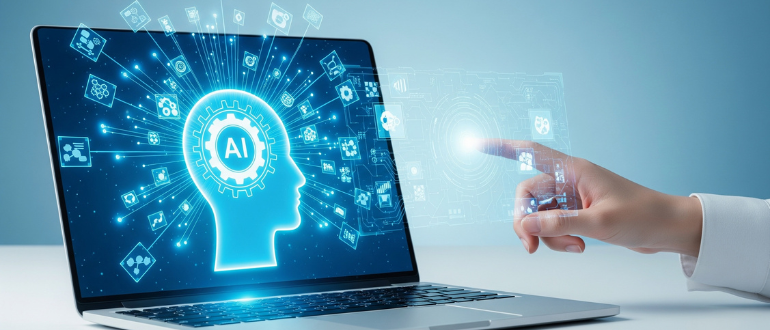
Every few months, the headlines return: AI is about to swallow humanity whole. The latest volley? ChatGPT has now passed the Turing Test. That most internet content is about to be “dead” — fake, bot-run, AI-generated. That jobs are evaporating, and the environmental costs of building AI “factories” will doom us all. Sound familiar? It should. We’ve been here before. And yes, the naysayers have assembled once again. Kind of like the folks in Times Square who are always out, urging us to repent before God destroys us or something.
The Turing Test Strikes Again
PopSci recently ran a headline that stoked the usual fears: “ChatGPT passed the Turing Test. Now what?” According to the article, in a study, ChatGPT-4.5 fooled 73% of people into thinking it was human. That’s a headline-worthy stat — indeed, significant. But as my old saying goes: Metrics make good copy, not always good policy.
“Passing the Turing Test” in this case doesn’t (yet) equal AGI, consciousness, or anything like that. It’s about mimicry, performance and “human-likeness” in text. It’s a measure of deception (or illusion), not understanding. Still, once a machine starts being mistaken for a human, folks begin whispering of runaway intelligence, identity, autonomy and all the rest of the AI dire warnings.
The Dead Internet & Sam Altman’s Quandary
Then came the El País coverage of the “dead internet theory,” which argues that bot-generated content and AI are rising faster than organic human voices, drowning out the real in favor of the artificial. Even more interesting: Sam Altman himself, head of OpenAI, has said he never took the theory seriously — until recently. He tweeted, “There are really a lot of LLM-run Twitter accounts now.”
Never mind that he might be throwing shade on Elon with that one. The irony here is delicious. The man building one of the biggest AI systems is worried about its side effects — disinformation, manipulation, loss of human signal turned to noise. If the creator is uneasy, maybe there’s something to the warning. But the “dead internet” is often painted in apocalypse tones: Shadows creeping across the web, human users wandering through AI-generated dross, wondering if anyone is real anymore.
Jobs, Carbon, & Factory Fears
Beyond mimicry and internet “death,” the standard doom menu includes:
- Jobs lost versus jobs gained. A WEF report suggests that generative AI and related tech will displace many roles (clerical, customer service, routine) even as new ones emerge.
- Environmental cost: AI isn’t free. It consumes power, water, cooling infrastructure; data centers need electricity, often from non-renewable sources. El País reported that companies like Microsoft and Google have seen massive year-to-year growth in energy and water consumption and carbon emissions tied in part to generative AI workloads.
- Infrastructure creep: These “AI factories” — massive data centers, networks, storage farms—are being built on a scale with only partial accounting for their full ecological and societal cost (not just dollars, but water tables, e-waste, heat, inequality).
Even Techstrong.IT and Techstrong.AI have several articles on this topic.
All of this fuels the narrative: Midnight is imminent. The AI doomsday clock ticks ever closer.
But Wait — The Other Side of the Coin
Here’s where nuance sneaks in:
- The Turing Test being passed (or approximated) doesn’t mean machines understand anything the way humans do. It means they are better at convincing us that they do. Illusion doesn’t equal insight.
- The dead internet theory, while provocative, often lacks rigorous empirical boundaries. Yes, more content is being generated by algorithms and bots. But human-creators are not disappearing. Community, originality, human emotion, error, absurdity — they persist. Sometimes what looks like “AI-noise” is simply volume exceeding our capacity to distinguish one voice from another.
- Regarding jobs: History shows us that many technologies that seemed to threaten employment eventually changed the nature of work rather than ending it. Some roles vanish; others emerge. There is risk, but also opportunity.
- On environment: Yes, AI large-scale operations use resources. But a lot of investment is going into efficiency, renewables, better cooling, green energy, sustainable datacenter design. Not perfect, but nontrivial.
Shimmy’s Take
So where do I land? Are these warnings hokum, exaggeration, or mistaken alarm? Not entirely. There are real concerns — some immediate, some farther on the horizon. But I refuse to believe we’re facing an unstoppable treadmill to disaster. My gut tells me things will work out. Not always nicely. Not always fast. But muddling through is what we do best.
The days are long. Every week, there seems to be some new AI alarm: A test passed, a doom-laden prediction, an article proclaiming we’re technologically doomed. But the months are short. Look back: In two or three years, we’ve gone from “what is ChatGPT” to “can you tell it from a person.” We’ve seen improvements in energy efficiency, policy discussions and ethical frameworks. We’ve seen AI adopted in healthcare, education and manufacturing — not without missteps, but adopted and useful.
We’ll struggle with regulation. We’ll argue about truth and misinformation. We’ll lose some jobs, and yes, we’ll pay environmental costs. But humanity has always adapted. We absorb shocks. We ritualize the fear. We make laws, build oversight. We urge transparency. And slowly, we find a way forward.
So yes, the naysayers are doing their thing again. They always do. And maybe they’re good for us — forcing conversations we otherwise ignore. But I don’t see the end of the world in the prompt history. I see incremental progress, moral grappling, occasional chaos — and ultimately, resilience.
To quote The Raven (because I’m a writer and love quoting after midnight): “Same as it ever was.”
In summary: Be wary of sweeping proclamations, but not blinded by fear. The AI-apocalypse might make for great headlines — but history tells me it won’t make for a good ending.
Despite the alarm, overhype and legitimate worries, we aren’t heading into a catastrophe tomorrow. We’ll deal with messes, adapt our ways, and build what we need over what we fear. Progress is messy. But it’s real. And in time we’ll look back and marvel not at how fearful we were — but how far we came.

